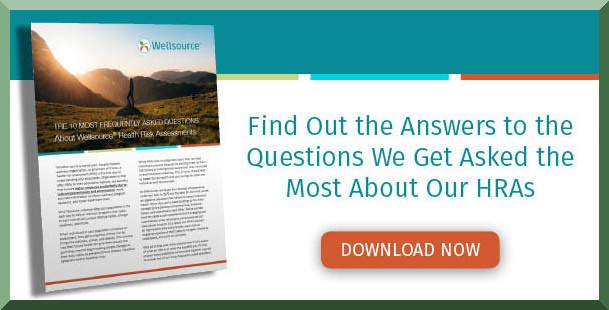We hope our readers will enjoy a re-post of this article, written by our CEO Chris McReynolds. It was published back in August in Health IT Outcomes. You can read the original article here.
Health and wellness professionals can describe the high cost conditions prevalent in their populations. They also can tell you that the best time to intervene is before a person enters a chronic disease state. That’s why they are so interested in identifying behaviors that lead to diabetes or heart disease and improving lifestyle habits prior to diagnosis. Improved habits can improve clinical health outcomes. Information comes before intervention, however, and that’s why it is an exciting time to be in the population health field. Technology advances allow for a more personalized collection of data as well as for targeted interventions that can increase engagement and improve health outcomes.

In the emerging era of artificial intelligence (AI), multiple data points – consumer data, socioeconomic data, claims data, chart notes, self-reported data collected by a health risk assessment, data from wearables – can be combined and analyzed to guide individuals to healthy habits such as:
- Suggesting healthier alternatives when ordering groceries online
- Recommending recipes that comply with health conditions
- Reminding individuals to exercise, relax, or get ready for bed
- Adding notes to EMRs that can inform patient-physician discussions during appointments
The possibilities are as limitless as they are enticing. But there’s an inescapable reality: AI is only as good as the data it has to work with. If you start with reliable data, you dramatically increase the chances of positive outcomes. Analyze old data, and you’ll get out-of-date results. Put in flawed data, and you’ll get unreliable, perhaps even undesirable, results. To borrow an old computer adage, it’s “garbage in; garbage out.” Accurate data, on the other hand, allows health and wellness professionals to identify behaviors and conditions that put individuals at risk for future health problems and intervene before someone develops a chronic disease.
While health and wellness professionals now have more data than ever before to help guide effective healthy lifestyle interventions, the primary way to collect health and lifestyle data is still through self-reported information. Some examples include:
- Clinicians administer the Patient Health Questionnaire (PHQ-2) or a similar question set to identify individuals at risk for depression. Validation studies found that it is a reliably sensitive tool for identifying the possibility of depression.
- Emergency rooms ask patients to self-report their pain level. A systematic review studied three of the pain scales and found all three to be valid and reliable.
- Health professionals collect self-reported information on chronic conditions, lifestyle behaviors, and health status. Research shows these kinds of data are “reasonable predictors” of future health costs.
- Self-reported height and weight can be “a reasonable proxy measure” for clinical values.
- Self-rated health is a valid predictor of mortality and indicator of overall health.[6]
Addressing Self-Report Limitations
To some degree, self-reported data is subject to bias. For example, an individual might not recall accurately how many fruits or vegetables they ate last week, or they might exaggerate the amount of exercise they get because they want to appear healthier. They also might be unwilling to share personal information because they don’t trust the security of the data system. Researchers are actively looking at technology-based methods for collecting health and lifestyle data, such as wearables and online food trackers, but they haven’t succeeded in creating fully reliable techniques.
Lifestyle information collected from an individual by way of self-report can provide valuable insight into individuals’ habits and thoughts and result in better health. For example, using digital devices to collect self-reported symptoms improves health outcomes and quality of life for cancer patients. Technology that collects self-reported data can contribute significantly to health and wellness—as long as it is reliable. It makes sense for health and wellness professionals to do all they can to increase the reliability and analysis of self-reported data to improve health outcomes. Here are four best practices.
1. Accessibility
An individual can interface with a smartphone or virtual assistant from nearly anywhere in the world. The consequence to this ubiquitous technology is that individuals now view life in sound bites and viral images. The new accessibility challenge is attention span. Short attention spans require responsive applications with minimal load time. A high performance user interface, and the ability to quickly customize or modify content can only emerge from modular design principles, leveraging responsive client-side frameworks, combined with an efficient and scalable data management architecture for the back end. Producing applications that can keep up with the expectations of today’s digital consumer requires investing in these technology foundations or their equivalent. A fast application helps keep an individual interested and engaged. For example, when Wellsource doubled the performance of our health risk assessment application, completion rates increased by 47 percent.
2. Trust
Anything that collects self-reported data—whether it’s a virtual assistant device, a nutrition app, or anything else—must adhere to best practices for security and privacy. In a nationwide survey, more than half (59 percent) of American adults expressed concern that their data is not secure. More than one in ten (12 percent) admitted to withholding information because of it. It’s no surprise that Americans feel this way; even organizations you may think are secure still face scrutiny from individuals (Capital One, anyone?). People are more likely to give accurate, honest answers when they feel the entity collecting their information adheres to practices that ensure confidentiality, such as regular training on HIPAA compliance; security awareness; fraud waste and abuse; and research methods.
Now that Alexa is HIPAA-compliant, Siri, Cortana, and Google are likely to also queue up to collect health information. Because individuals can “talk with” voice-activated personal assistants, these devices will mitigate some of the roadblocks that online forms and questionnaires inherently have, such as relying on robotic-sounding screen readers for vision-impaired access or requiring a level of computer savvy to log into and navigate a questionnaire or online diary. But only if individuals feel confident that their data is safe. Virtual assistants must adhere to the same stringent privacy and literacy requirements as hospitals, health risk assessment vendors, and doctor’s offices to increase the validity of the data they collect. Specifically, every entity that collects or stores personal information should encrypt data to obscure personally identifiable information, both during transmission and at rest. This is foundational, and something reputable data collection companies have done for a very long time.
“Security best practices must be comprehensive across the application, infrastructure, and data domains. Additionally, any data store used for population health should be architected with at least column-level encryption and transactional auditing,” says John Kiser, Wellsource Director of Software Development. “The act of viewing this data is protected on a need-to-know basis. If you don’t have authorization you will not see the data in specific columns when the data is returned. This should be automatic and always enforced by the underlying system.”
Assuming an organization follows best practices, the next hurdle is to make sure individuals know those policies and procedures are strictly adhered to by prominently displaying certifications and compliance statements on public-facing materials. If a population’s confidence level is low, provide consistent messaging about staff training, data encryption, auditing, and other ways your organization ensures data is secure.
3. Personalization
Remember “garbage in; garbage out”? The more engaged participants are in the process, the more likely they will be to provide accurate information. One way to increase engagement is through quality application design that allows for a personalized approach. For example, when communicating with your population, ensure your messaging adheres to literacy guidelines and considers the unique attributes of your target audience. Just 15 years ago, for example, I saw health risk assessments asking generic question sets with a lot of “if” statements, such as “How many cigarettes do you smoke each day? (If you don’t smoke, skip to question 34.)” or “Are you pregnant? (women only).”
Today, algorithms personalize the user experience based on a person’s demographics (e.g., sex, age), preferences, and risk factors. Data collection surveys should be designed using selection algorithms to ensure an individual is only asked appropriate follow-up questions that are specific to their situation, minimizing survey fatigue. This kind of personalization—whether in a health risk assessment, wellness program messaging, or patient outreach—takes a lot of effort, but it’s a huge contributor to achieving engagement, especially with younger generations. In 2012, Innerscope Research observed that digital natives switch attention as often as every other minute, resulting in low engagement. Ten years ago, a personalized experience delighted end user; today they’re growing to expect it.
Leveraging machine learning to collectively analyze self-reported, commercial, and claims data in real time allows health and wellness providers to update their outreach and recommendations when an individual’s circumstances change, like when an individual breaks their leg or says they are feeling a lot of financial stress. Better personalization drives better engagement which ultimately drives better outcomes.
4. Compatibility
Interoperability is more than a Centers for Medicare and Medicaid (CMS) initiative. It’s essential for achieving integrated health and wellbeing. That’s why, in addition to being reliable as stand-alone data sets, any data intended for population and wellness professionals should be universally compatible. Of course, that’s easier said than done. Until CMS releases guidelines on interoperability standards, health and wellness professionals should be sure that at the very least, data is programmed for easy integration. Chart notes, consumer data, claims data, socioeconomic data, and self-reported data each have unique formatting requirements and use disparate systems; however, ensuring that they can be easily integrated for a seamless user experience should be at the forefront of health professionals’ minds.
One aspect of interoperability includes patient access to their own data. This requires health and lifestyle data to be “human compatible.” When an individual is given the opportunity to keep their health and lifestyle information current, AI will be able to identify increasing risk for chronic disease or psychological distress and either initiate interventions or alert health and wellness professionals who can quickly adapt intervention strategies based on that updated information. To increase the reliability of self-reported data, such as lifestyle behaviors and health history, patient-facing information should be easily navigable and follow health literacy guidelines.
Effective Prevention Efforts Depend On Accurate Data
The reliability of the data analysis—whether performed by a machine or a highly skilled human—depends on the quality of data that is being used. Much of the data that has the highest potential for identifying lifestyle behaviors linked to future health problems comes from asking individuals about their health, feelings, and habits (self-report). Health and wellness professionals must do all they can to elevate its reliability.








